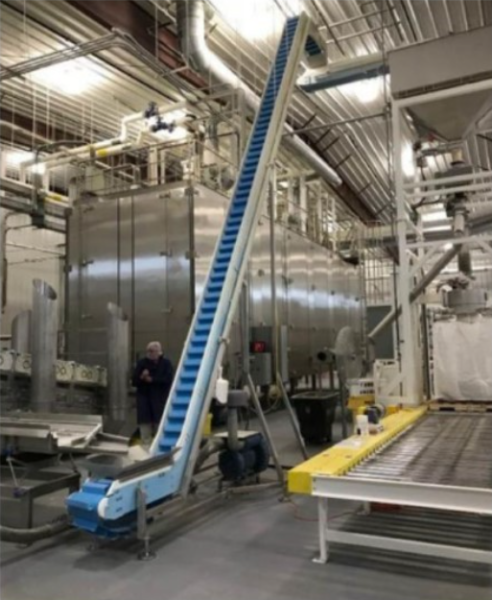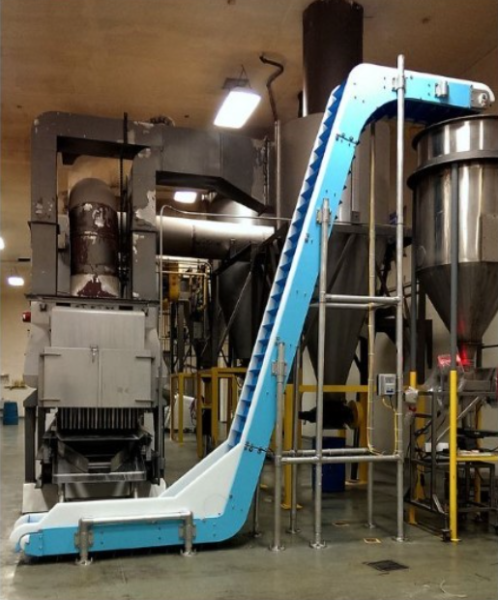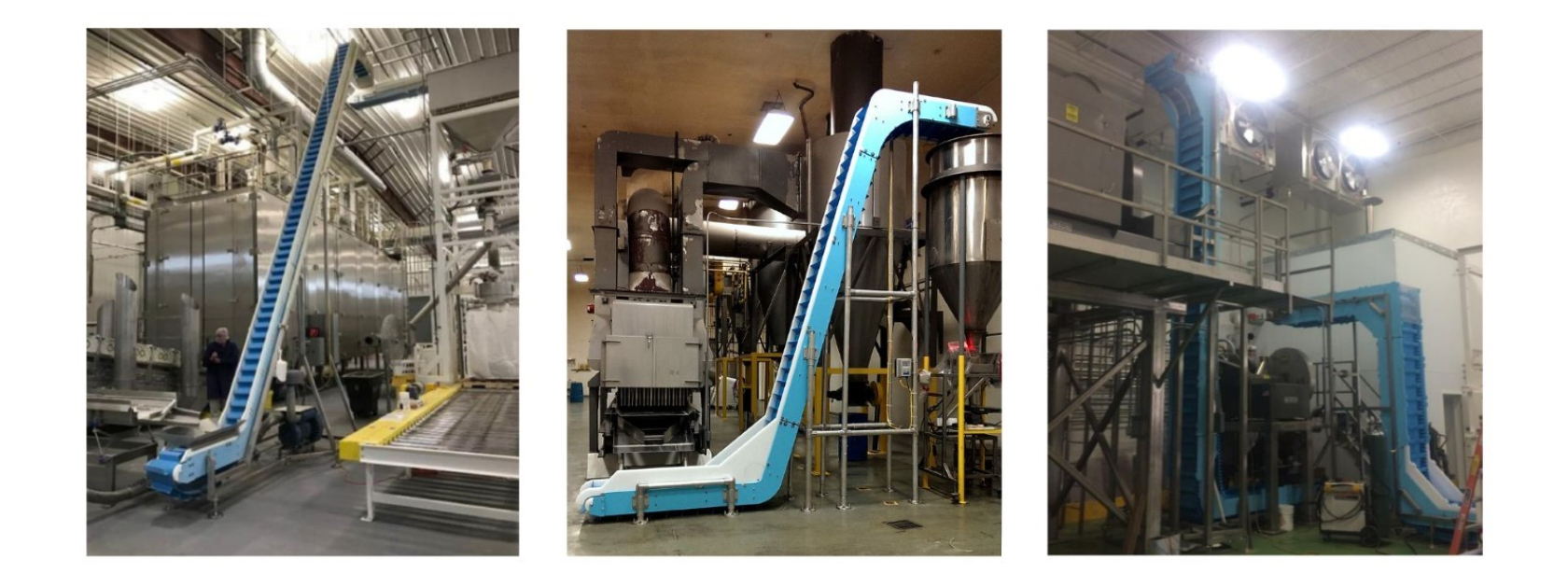Minimizing the footprint of your equipment is a critical element to the success of your operation. Dynamic Conveyor’s DynaClean food conveyor systems are designed and built to rise to your challenge, meet your specific demands and maximize space in your production facilities.
 While working in the Food Industry, attending trade shows, and demonstrating our conveyor systems, we frequently get asked: How high can your food conveyors go? The answer is we’ve designed and manufactured sanitary conveyors that reach heights of twenty-five feet or more.
While working in the Food Industry, attending trade shows, and demonstrating our conveyor systems, we frequently get asked: How high can your food conveyors go? The answer is we’ve designed and manufactured sanitary conveyors that reach heights of twenty-five feet or more.
Vertical conveyors from Dynamic Conveyor are often preferred over bucket conveyors or bucket elevators due to their ease of cleaning, ability to better contain product, less mechanical components, and space-saving design, allowing for efficient use of limited floor space in industrial settings. Additionally, vertical conveyors provide continuous and smooth transportation of materials, minimizing the risk of spillage and product damage compared to the intermittent nature of bucket conveyors. Furthermore, vertical conveyors offer greater flexibility in handling a variety of materials, sizes, and shapes, making them a versatile choice for vertical transport applications.
The important considerations for designing and building a vertical conveyor to transport food and related products to great heights are:
- Throughput: The primary consideration in designing any conveyor system is the necessary throughput. Alongside bulk density, throughput serves as the foundation for various design calculations, influencing decisions on belt type and conveyor speed. At Dynamic Conveyor, our conveyor designs incorporate a minimum 20% buffer to empower customers to enhance their throughput, especially during peak periods. This approach ensures flexibility and accommodates increased demand, offering a responsive solution to varying production needs.
- Belting: Choosing the right belting for an application stands as a pivotal decision. Key considerations revolve around belt strength, ensuring it can adeptly manage the pull experienced during conveyance. At Dynamic Conveyor, the selection process involves using engineering tools to match the ideal belt with factors like product bulk density, throughput, conveyor design, and transition points. Moreover, the selection of proper flight and scoop arrangements becomes crucial to meet process throughput requirements, particularly in minimizing product loss on vertical conveyors. Equally significant are aspects like product release and ease of cleaning, which factor into the meticulous process of belting selection.
 Motor Size: When sizing a motor for a vertical conveyor, a thorough evaluation of several factors is essential to guarantee peak performance. Critical factors encompass the required throughput, conveyor length, material weight, and the conveyor’s angle of inclination. These aspects collectively decide the power required to efficiently drive the conveyor system. It is crucial to match the motor size to handle both regular operation and any potential fluctuations during start-up or load changes. Moreover, fully loaded vertical conveyors at a standstill might encounter motor back driving. To prevent product back driving off the feed end, Dynamic Conveyor suggests incorporating a brake to ensure stability in such scenarios.
Motor Size: When sizing a motor for a vertical conveyor, a thorough evaluation of several factors is essential to guarantee peak performance. Critical factors encompass the required throughput, conveyor length, material weight, and the conveyor’s angle of inclination. These aspects collectively decide the power required to efficiently drive the conveyor system. It is crucial to match the motor size to handle both regular operation and any potential fluctuations during start-up or load changes. Moreover, fully loaded vertical conveyors at a standstill might encounter motor back driving. To prevent product back driving off the feed end, Dynamic Conveyor suggests incorporating a brake to ensure stability in such scenarios. - Safety: Safety is an important consideration for vertical conveyors. Conveyors and accessories must be properly supported. Permanently mounted conveyors typically employ a combination of floor support and ceiling-hung supports to minimize their footprint. In instances where conveyors need casters, a scaffold design with a large footprint is often necessary to prevent tipping during transport. Additionally, Dynamic Conveyor always recommends covers on both sides of the conveyor to protect from any pinch points as well as hazards from falling product. This comprehensive approach to safety underscores the commitment to creating secure working environments when using vertical conveyor systems.
- Maintenance: Considering the nature of vertical conveyors, they can be challenging to access easily and safely. A robust conveyor design using quality components and design simplicity can ensure that any required maintenance is kept to a minimum, and where needed, can be conducted safely with minimal impact to daily operations. Dynamic Conveyor takes pride in the fact that its conveyors require minimum maintenance and are easy to clean. Regular inspection is recommended especially when transporting food to great heights. See our Conveyor Care Blog Series – Part 1 and Part 2 for more information.
Happy food manufacturing customers say that DynaClean Z-conveyors have proven themselves to be excellent replacements for bucket conveyors. If you want to move food to new or existing heights smoothly, contact us for a consultation with our professional sales and engineering team who can advise you on a food conveyor system that will meet your needs.


